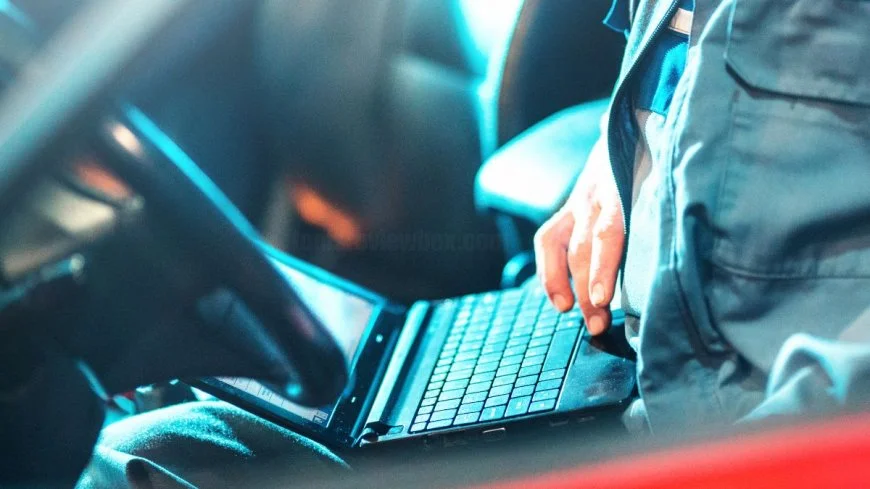Learn How to Run Diagnostics on Your Lenovo Laptop: A Simple Guide
Learn how to run diagnostics on a Lenovo laptop in just a few easy steps. This guide covers built-in tools, troubleshooting tips, and common tests to help keep your laptop in top shape.

Whether your Lenovo laptop is running slower than usual or you're facing an unexpected issue, running a diagnostic test can help you identify the problem quickly. By performing diagnostics, you can pinpoint hardware or software issues before they escalate into larger problems. This guide walks you through the steps to run diagnostics on your Lenovo laptop, so you can troubleshoot like a pro in no time.
Running diagnostics on a Lenovo laptop is a straightforward process that helps identify hardware and software issues. Lenovo laptops come equipped with a built-in diagnostic tool called Lenovo Diagnostics. You can access this tool by restarting your laptop and pressing the F12 key when the Lenovo logo appears. From there, navigate to the diagnostics option and follow the on-screen instructions to check for hardware malfunctions, such as RAM, CPU, or battery issues.
Understanding how to run diagnostics on your Lenovo laptop can save you time and money by catching potential problems early. Instead of waiting for an issue to worsen, these simple steps help you diagnose the problem yourself. Whether you’re a tech enthusiast or someone just looking for a quick fix, this guide provides everything you need to keep your laptop running smoothly.
Figuring Out Laptop Diagnostics
Why Diagnostics Matter
Listen, diagnostics are like a tech GPS. They find and fix issues in your gadgets—whether it’s the hardware, software, or network. They save you from those annoying tech headaches by spotting problems early. Regular checkups keep your device running smoothly and help you dodge bigger issues down the line (Lenovo).
Diagnostic Tool Tiers
When it comes to Lenovo laptops, you've got two main diagnostic tool options: hardware and software.
| Diagnostic Tool Type | What They Do |
|---|---|
| Hardware Diagnostics | Tests parts like your processor, memory, hard drive, and graphics card. It hunts down specific hardware issues and tells you exactly where the problem is. |
| Software Diagnostics | Dives into software problems like bugs, crashes, and lag. It figures out which part of your software is acting up, so you can fix it right away. |
With a grasp on hardware and software diagnostic tools, you can keep your Lenovo laptop in tip-top shape and running like a dream.
Lenovo Diagnostic Solutions
What’s the Deal with Lenovo Diagnostics?
Lenovo’s got your back when it comes to troubleshooting your laptop. They have a bunch of handy tools to help you figure out and fix all sorts of pesky issues. Whether it's a hardware hiccup or a software snafu, Lenovo diagnostics provide essential support. Plus, you get handy alerts about potential recalls or safety issues (Lenovo Support). These tools make it easy for you to get to the bottom of what’s bugging your device.
They've got tools for both hardware and software problems. For hardware, think things like your processor, memory, hard drive, and graphics card. For software, it’s all about hunting for bugs, crashes, and those annoying slowdowns (Lenovo). This mix means you’re well-equipped to tackle whatever comes your way.
Why Bother with Lenovo Diagnostics?
Here’s why using Lenovo’s diagnostic tools is a good idea:
| Why It’s Awesome | What It Does For You |
|---|---|
| Speedy Fixes | Quickly pinpoint what’s wrong so you can fix it fast. |
| Thorough Checks | Find out if there’s something wrong with the major parts of your laptop. |
| Software Sleuthing | Get to the bottom of software bugs and speed issues to keep things running smooth. |
| Performance Boost | Regular check-ups keep your laptop in tip-top shape. |
| Easy Peasy | You don't have to be a tech genius to use these tools. |
Using these tools not only keeps your laptop running smoothly but also makes life a lot easier. Taking care of your device means it’ll last longer and work better. Got a specific problem? Check out these guides: how to start a Lenovo laptop in safe mode or how to unlock the touchpad on a Lenovo laptop.
How to Run Diagnostics on Your Lenovo Laptop Without the Headache
Getting your Lenovo laptop back on track can be as simple as running a few diagnostics. Follow this handy guide to nip potential issues in the bud and keep your laptop running like a dream.
Easy-to-Follow Steps
To run diagnostics on your Lenovo laptop, just go through these steps:
- Fire Up Lenovo Vantage:
- For Windows 10/11: Hit the Start button, type "Lenovo Vantage," and open it up. If you can’t find it, swing by the Lenovo website and grab it.
- Find Diagnostics:
- In Lenovo Vantage, look for the "Diagnostics" section where you’ll find hardware and software tests all lined up.
- Pick Your Test:
- Decide which diagnostic test suits your needs. Options include battery life checks, memory tests, and hardware inspections.
- Follow Instructions:
- The tool gives clear instructions. Just follow along to make sure everything goes smoothly.
- Check the Results:
- When the test wraps up, you’ll get a summary showing what’s working and what’s not.
- Take Action:
- If any problems pop up, Lenovo Vantage offers suggestions to fix them. It’s like having a tech guru in your corner.
| Step | Action |
|---|---|
| 1 | Open Lenovo Vantage from the Start menu. |
| 2 | Go to the Diagnostics section. |
| 3 | Choose the diagnostic test you need. |
| 4 | Follow the on-screen instructions. |
| 5 | Look at the test results. |
| 6 | Follow any recommendations provided. |
Making Sense of Diagnostic Results
Understanding your laptop’s diagnostics can make all the difference. Here’s a quick cheat sheet:
- All Clear:
- If no issues pop up, breathe easy – your laptop’s in good shape. Regular check-ups are still a good idea.
- Warnings:
- A warning hints at potential troubles down the line. Maybe your battery’s not what it used to be, or your memory’s stretched thin.
- Errors:
- Errors mean parts of your laptop aren’t doing what they should. Common culprits include:
- Failing hard drives.
- RAM (memory) acting up.
- What to Do Next:
- Lenovo Vantage often throws in handy fixes or steps to take. Whether it's updates or hardware swaps, these tips can save you a lot of hassle.
By running diagnostics and keeping an eye on the results, you can stay ahead of problems and keep your Lenovo laptop in tip-top shape. For more handy tips, check out our guide on how to speed up your Lenovo laptop. Happy computing!
Hardware Diagnostics for Lenovo
Got a Lenovo laptop acting up? It's like your tech's saying, "Help me!" Well, keeping your device running smooth and slick isn't just about luck; it's about using the right tools to catch problems early.
Poking and Prodding Hardware Components
Using diagnostics tools is like giving your laptop a health check-up. These handy tools let you peek under the hood without actually grabbing a screwdriver. They scrutinize key parts like the processor, memory, hard drive, and graphics card. It's like having a tech whiz as a roommate who helps you pinpoint problems and zap them before they snowball. Here’s a cheat sheet for the key parts and the tools you'll need:
| What’s Acting Up | What to Use |
|---|---|
| Processor | Performance Monitor |
| Memory | Task Manager |
| Hard Drive | Disk Check Utility |
| Graphics Card | Performance Monitor |
These aren't just random names – these tools can save you from endless buffering, crashes, and that dreaded blue screen of death. Use them to sniff out trouble and keep everything running buttery smooth.
Fixing Hardware Snags
Found a glitch? Time to roll up the sleeves and get fixing. Here's your no-nonsense guide to tackling those pesky hardware issues:
- Check Connections: Make sure everything’s plugged in nice and tight. RAM sticks, cables - if it's got a connection, double-check it.
- Run Diagnostic Tests Again: Sometimes a second opinion doesn't hurt. Rerun those diagnostics to confirm the culprit.
- Replace Faulty Hardware: If something's dead, it's dead. Swap out the busted part. Your user manual will be your new best friend here.
- Update Drivers: Outdated drivers are like expired milk – not good. Keep them fresh to avoid hiccups.
- Call in the Pros: Stuck? Lenovo Support's got your back. They can walk you through it or even take over if need be.
Follow these steps and your Lenovo will thank you by being its best self. For more pro tips on boosting your Lenovo's pace, check out this guide. Feeling extra cautious? Dive into preventive maintenance to dodge future tech drama. Happy fixing!
Software Diagnostics for Lenovo Laptops
Spotting Software Headaches
Using software diagnostic tools for Lenovo laptops can save you from dealing with endless bugs, app crashes, or just painfully slow performance. These handy tools dig deep to find what's causing the headaches so you can fix it fast (Lenovo).
Common software problems that get diagnosed include:
| Problem | What's Going Wrong |
|---|---|
| Crashes | Apps shutting down unexpectedly |
| Compatibility | Apps not playing nice with hardware |
| Performance Slows | Laggy speeds or frozen apps |
Diagnostic tools test and gather info, spitting out reports that show you where things have gone south. Regular check-ins can keep your laptop humming along nicely.
Fixing Software Problems
Once you've figured out what's wrong, it's time to get down to troubleshooting. Here are some usual steps:
- Update Everything: Fresh updates for your OS and apps can squash bugs.
- Reinstall Buggy Apps: If an app is a repeat offender, reinstall it.
- Watch Performance: Tools that log CPU, memory, and disk usage can point out resource hogs (Lenovo).
| Troubleshooting Step | What's It For |
|---|---|
| Update Software | Squash bugs, boost security |
| Reinstall Apps | Clear out stubborn errors |
| Monitor Performance | Pinpoint and fix laggy bits |
By following these steps, you'll keep software glitches at bay. Need more help? Check out tips on how to speed up your Lenovo laptop. Smooth-running software and well-oiled hardware make using your laptop a breeze.
Keep Your Laptop Happy with Regular Check-Ups
Catch Problems Before They Catch You
Running regular diagnostics on your system is like giving your laptop a health check-up—it helps spot any issues before they cause a bigger headache (Lenovo). You can scan both hardware and software to make sure everything’s ticking along nicely. Think of it as preventive care that keeps your laptop from unexpectedly crashing when you need it most.
Here’s why you should make diagnostics a regular habit:
| What It Checks | Why It’s Handy |
|---|---|
| Early Issue Spotting | Detects hardware or software glitches before they become big problems. |
| Performance Tracking | Keeps an eye on system speed—no one likes a laggy laptop. |
| Hardware Testing | Runs checks on CPU, RAM, and other crucial parts. |
| Security Scanning | Flags any security weak spots that need patching. |
When you get in the habit of checking, you’re more likely to catch aging hardware or software hiccups early. This means your laptop stays in peak condition longer, and you spend less time fixing unexpected issues.
Get the Most Out of Your Laptop
Diagnostics tools aren’t just for spotting problems—they also help you beef up your laptop’s performance by giving you a peek under the hood (Lenovo). Here’s what you can learn:
| What It Measures | Why It Matters |
|---|---|
| CPU Usage | Shows you how much your processor’s pumping. If it’s always high, your laptop might need a break. |
| Memory Monitor | Tells you if you’re maxing out your RAM. More RAM could mean smoother multitasking. |
| Disk Activity | Checks how fast your hard drive or SSD is working. Slow speeds might mean clutter or failing hardware. |
| Internet Speed | Measures how fast you’re really cruising online. Problems here might mean your Wi-Fi setup needs a tweak. |
By keeping an eye on these metrics, you can tweak settings to keep your laptop running fast and smooth. It’s all about making sure your Lenovo is serving you well, whether you’re working, gaming, or just browsing. Need more tips? Check out articles like speeding up your Lenovo laptop or unlocking your touchpad.
Keep your laptop in shape, and it’ll keep your digital life running smooth!
Final Thoughts: How to Run Diagnostics on Lenovo Laptop
Running diagnostics on your Lenovo laptop is an essential part of keeping it healthy and functioning optimally. Whether you're experiencing performance issues or just want to ensure everything is running smoothly, using Lenovo's built-in diagnostic tools is a smart move. These tests can help you catch problems early, allowing you to address issues before they get worse. By regularly checking your laptop’s health, you can extend its lifespan and avoid unexpected downtime.
FAQs about "How to Run Diagnostics on Lenovo Laptop"
Q: How do I access Lenovo's built-in diagnostic tool?
A: To access Lenovo Diagnostics, restart your laptop and press the F12 key when the Lenovo logo appears. From there, select the diagnostics option and follow the instructions to run various hardware tests.
Q: What types of problems can Lenovo Diagnostics detect?
A: Lenovo Diagnostics can identify a variety of hardware issues, including problems with the RAM, CPU, hard drive, and battery. It also checks for software errors that could affect system performance.
Q: Can I run Lenovo Diagnostics without restarting my laptop?
A: Yes, Lenovo Diagnostics is available in two versions: bootable and within the operating system. The bootable version requires a restart, while the in-OS version can be accessed directly from your Windows desktop by downloading the software from Lenovo’s official website.
Q: What should I do if Lenovo Diagnostics detects an issue?
A: If a problem is detected, Lenovo Diagnostics will provide you with error codes. You can look up these codes on Lenovo’s support page to determine the next steps, such as replacing faulty hardware or updating drivers.
Q: How long does it take to run a full diagnostic on a Lenovo laptop?
A: A full diagnostic test can take anywhere from 10 minutes to over an hour, depending on the components being tested and the complexity of the issue. Quick tests, like battery or RAM diagnostics, usually take only a few minutes.
What's Your Reaction?







































![MacBook Pro M5: All the features and specs you need to know [LEAKS REVEALED]](https://tomsreviewbox.com/uploads/images/202502/image_430x256_67bd6d7cd7562.jpg)


























